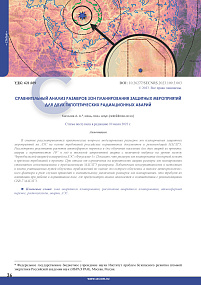Comparative analysis of protective action planning zones for two hypothetical radiation accidents.
Kiselev A. A.
The paper addresses the practical issues of modeling the sizes of emergency planning zones around NPP based on the requirements of the Russian regulatory documents and IAEA recommendations. The results of calculations of the atmospheric transfer and radiation doses to members of the public have been considered for two accident scenarios taken fr om the design documentation: a beyond design basis accident with a probability of 10–7 per year, and a severe beyond design basis accident with a release that can be rated between the Chernobyl accident and the accident at the Fukushima-1 NPP. It has been shown that the emergency planning zones sizes for the first accident correspond to the requirements for the NPP design. Without restrictions on the accident probability, the size of the emergency planning zones becomes comparable to the IAEA recommendations. An excessive conservatism in exposure pathways, approximations for acute radiation doses, and a weather factor lead, in some cases, to a significant increase in the size of emergency planning zones and emergency planning distances, which requires their adaptation while acting in the regulatory field, wh ere the hazard analysis is adopted in compliance with the recommendations of the IAEA Safety Standards Series No. GSR Part 7.
► Keywords: emergency planning zones, emergency planning distances, atmospheric transfer, radionuclides, accidents, NPP.
Article language: Russian. Pp. 36–49. [in Russian]. 10.26277/SECNRS.2023.109.3.003.
Comparative analysis of protective action planning zones for two hypothetical radiation accidents
Author:
Kiselev A. A.
Issue:
3 (109) – 2023.


